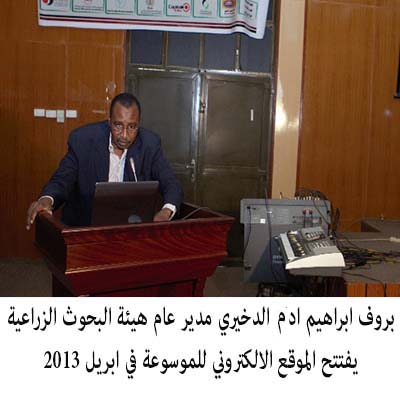الري
Effect of irrigation water quantity and tillage treatment on forage sorghum [Sorghum bicolor (L). Moench] cultivar Abu Sabein in saltaffected soil of Sudan.
Salah Abdel Rahman Salih1, Abdel Moneim Elamin Mohamed2 and Mohamed Abdel Mahmoud Elsheikh3
Abstract: This study was conducted during 2009 and 2010 summer seasons at the Demonstration Farm of the Faculty of Agricultural Technology and Fish
Science, University of Neelain (Jebal Awlia area) south of Khartoum to investigate the most suitable irrigation water quantity and the best tillage treatment for
growing [Sorghum bicolor (L). Moench] cultivar Abu Sabein in salt affected soil. The irrigation water quantities used were crop water requirement
(CWR) + 10% or 20% of the crop water requirement as a leaching fraction (LF). Three tillage treatments namely, disc plow, chisel plow, disc harrow were used and zero tillage as a control. The variables compared were plant height, number of leaves/plant, stem diameter, leaves/stem ratio, fresh and dry weight and water use efficiency. The soil of the site was found to be non saline, non sodic but calcareous soil with pH ranged from 7.5 to 8.0, SAR, from 1.7 to 10.0, ECe, from 0.6 to 3.0 ds/m, CaCO3, from 1.6 to 3.8. Average bulk density value obtained was 1.28 g/cm3 , average field capacity value obtained was 22.8% on dry weight basis, soil texture of the all depths is sandy clay loam. The results showed that CWR + 20% LF gave higher results than CWR + 10% LF, also chisel plow gave higher values than the other tillage treatments for all the variables during the two seasons.
A Comparative Study between Furrow, Furrow Basin and Border
Methods of Irrigation
Salah Abdel Rahman Salih1 and Abdel Moneim Elamin Mohamed2
Abstract:-The research work was conducted during two winter seasons of 1990/91 and 91/92 at the University of Khartoum Top Farm to determine the most
superior surface method of irrigation for irrigating hybrid maize. The methods studied were, the border, the furrow and the furrow-basin. The variables
compared were water applied, irrigation efficiencies and maize yield components.The results indicated that in the furrow-basin method less irrigation water was
applied and higher maize yield components were obtained compared to the furrow and border methods. With the exception of distribution efficiency, the furrowbasin method gave higher irrigation efficiencies compared to the other two methods. The results also showed no significant difference between the furrow
and the border methods with respect to irrigation efficiencies and maize yield components except that the border gave better distribution efficiencies than the
furrow method.
The Effect of Irrigation Water Quantities and Tillage Treatments in Leaching Salts in Salt-affected Soils.
1Salah Abdel Rahman Salih, 2Abdel Moneim Elamin Mohamed and 3Mohamed Abdel Mahmoud Elsheikh
1,3Department of Agricultural Engineering, Faculty of Agricultural Technology and Fish Science,University of Neelain.
2Department of Agricultural Engineering, Faculty of Agriculture, University of Khartoum.
ABSTRACT
This study was conducted during 2009 and 2010 summer seasons at the Faculty of Agricultural Technology and Fish Science Farm, University of Neelain (Jebal Awlia area) south of Khartoum to investigate the effect of different amounts of irrigation water and tillage treatments on salt leaching in the root zone. The water quantities used to leach the salts were crop water requirement (CWR) + 10% or 20% of the crop water requirement as a leaching fraction (L.F).Four tillage treatments namely, disc plow, chisel plow, disc harrow and zero tillage were used. The variables compared were pH, sodium adsorption ratio, electrical conductivity and calcium carbonate percentage. The results showed that CWR + 20% L.F. gave a higher leaching than CWR + 10% L.F. Whereas, chisel plow had the superiority in leaching of salts followed by disc
plow then disc harrow and last zero tillage. The best leaching resulted when CWR + 20% L.F. was used in combination with chisel plowing. Also the results showed that salts were leached from the upper soil layer to the lower ones during the two seasons.
A comparative study between soil chemical properties before and after
leaching of salts by irrigation water and tillage treatments in a calcareous soil
Salah Abdel Rahman Salih1 , Abdel Moneim Elamin Mohamed2 , Mohamed Abdel
Mahmoud Elsheikh3 and Abdel Rahman Mohamed Nour4
Abstract: The research was conducted during two summer seasons of 2009 and 2010 at the Demonstration Farm of the Faculty of Agricultural Technology and Fish Science, University of Neelain, to determine the different between some chemical composition of the soil before and after leaching of salts by irrigation water quantities and tillage treatments. The two water quantities used were crop water requirement + 10% or 20% of the crop water requirement as aleaching fraction. Four tillage treatments namely, disc plow, chisel plow, disc harrow and zero tillage were used. The variables compared were pH, sodium adsorption ratio (SAR), electrical conductivity (ECe) and calcium carbonate (CaCO3). The results indicated that pH and CaCO3 increased but SAR and ECe decreased during the two seasons.


